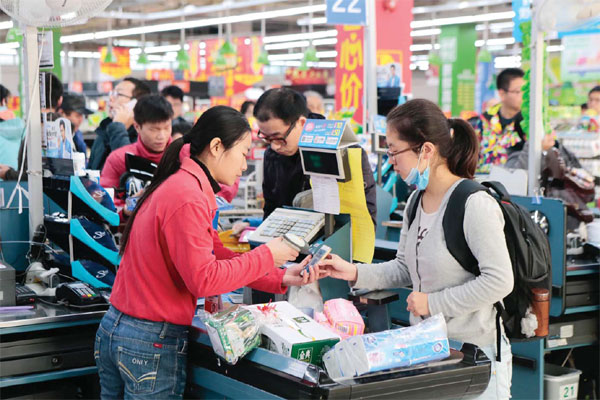Investors adjusting expectations
Updated: 2015-12-25 15:44
By Cecily Liu(China Daily Europe)
|
|||||||||||
China is now growing as a two-speed economy, with the slower, more traditional sectors making way for newer, dynamic industries.
Analysts say the shift from old to new will help China transition from rapid growth to a more sustainable, high-quality growth pattern, but it also has big implications for foreign companies investing in China and for industries worldwide.
So which Chinese industries are slowing and which are speeding up?
|
A woman makes a digital payment at a supermarket in Shanghai on Dec 12. Consumer spending and the services sector are increasingly driving growth. Photos provided to China Daily |
Simply put, heavy industries such as coal, cement, glass and steel - the backbone of China's economic growth for decades - are on the slide, while service-oriented industries such as healthcare, financial services, tourism and education, as well as those related to the Internet and alternative energies, are on the rise.
To put this in context, data released in October by the National Energy Administration show China's electricity consumption, which is most affected by heavy industry, has grown just 0.3 percent year-on-year, which indicates the old GDP drivers are nearly, if not already, in recession.
By contrast, the latest China index compiled by research company MSCI suggests newer industries are becoming true growth drivers. The index, which covers about 85 percent of China's equity universe, including large and mid-cap stocks, puts the country's growth at 5 percent. Yet if we discount the data for the banking sector (old and dominated by state-owned enterprises) and the energy sector (strongly linked with traditional, heavy industries) then the rate rises to 25 percent.
Yet experts say foreign investors in China need to recognize these varying speeds of growth to form realistic expectations. While China's growing consumption may be providing a large market for service-oriented companies, countries that rely on exports of commodities to China for growth may need to fundamentally adjust their long-term strategies.
"Often when Western firms look at China's economy, they immediately think of the manufacturing industry, which is slowing down, but that is not the whole story because now service industries account for about 50 percent of China's economy," says Hui Tai, chief market strategist in Asia for JP Morgan Asset Management.
Manufacturing is slowing, but it is also finding new ways to grow, he says. For example, the industry is increasing its use of big data, the Internet, automation and technology. Meanwhile, many new industries are emerging, and Hui predicts their share of China's economic growth will become more important.
"The rebalancing of China's economy has had larger implications than previously thought on the global economy," says Robert Bergqvist, chief economist for SEB bank in Sweden. "Apparently, the super cycle for commodities and energy seems to have come to an end, and world trade volume is now moving sideways.
"The world has become aware of China's importance for the global economy, and China's economic and financial challenges are shared by all countries around the globe, right now especially by many commodity- and energy-intensive exporters."
Sustainable vision
The two-speed structure implies slower average GDP growth in China overall. This year, during high-level discussions on China's 13th Five-Year Plan, the nation's blueprint for growth between 2016 and 2020 that will be finalized in March, the government said it had a target to double GDP between 2010 and 2020. This would require growing the economy by an annual average of 6.5 percent over the next five years.
This rate signifies a major slowdown from the double-digit growth that the country experienced over the past three decades, but it points to a more sustainable long-term growth model.
"China is reducing its GDP growth rate projections because it is realizing that a manufacturing-driven model is not sustainable, especially considering the adverse impact it has on the environment," says Kerry Brown, a professor of Chinese studies and director of the Lau China Institute at King's College, London.
"The country is in a process of transitioning into a more-diverse economy with bigger service and financial sectors. But as these sectors take time to build, China needs to accept a slower growth rate in the transitioning process."
The two-speed economy is a reality of that process, according to Fang Jian, managing partner in China for Linklaters, the London-based law firm.
Today's Top News
Asian Infrastructure Investment Bank launched
Russia says it has proof of Turkey's support for IS
Investors adjusting expectations
India and Russia eye nuclear, helicopter deals
Chinese club offers lucrative contract to Spalletti
Germany is AIIB's largest non-regional shareholder
Spanish PM to form new govt after elections
Two-child policy expected to be approved
Hot Topics
Lunar probe , China growth forecasts, Emission rules get tougher, China seen through 'colored lens', International board,
Editor's Picks

|

|

|

|

|

|







